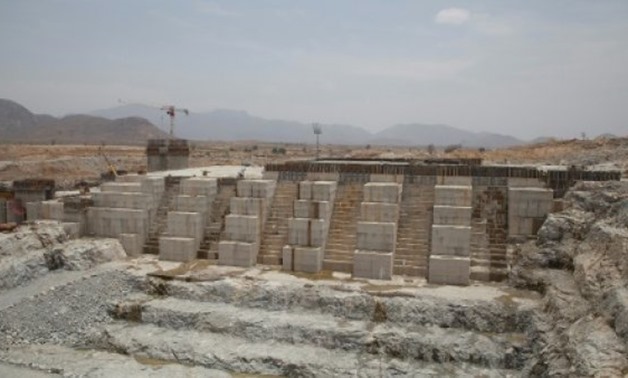
© AFP | A photo taken on March 31, 2015 shows the Grand Renaissance Dam under construction in Ethiopia near the Sudanese border
CAIRO - 14 January 2020: For the second day in Washington, meeting for the foreign and water ministers of Egypt, Sudan and Ethiopia resumed their talks on the Grand Ethiopian Renaissance Dam (GERD) in the presence of Minister of Foreign Affairs Sameh Shoukry.
The meeting was attended by US treasury Secretary Steven Mnuchin and World Bank President David Malpass.
Foreign Ministry Spokesman Ahmed Hafez said Egyptian and US officials held prolonged talks during which the Egyptian side expounded its vision on regulations that should be adopted to fill and operate the dam.
This meeting was followed by a meeting between the Egyptian, Ethiopian and Sudanese ministers for foreign affairs and water.
In Jan. 12, Ethiopian Prime Minister Abiy Ahmed announced that he asked South African President Cyril Ramaphosa to mediate to find solutions to the disagreement between the three countries after the latest round of negotiations ended in stalemate.
“As for Cyril Ramaphosa, he is a good friend for both Ethiopia and Egypt and is the upcoming president of the African Union. He can make a discussion between both parties to solve the issue peacefully because peace is the foundation of everything here in Africa,” said Ahmed in his speech on Saturday.
“That is why he can mediate as a brother between Ethiopia, Egypt and Sudan. I am sure that he will play a significant role in bringing us a win-win approach,” he added.
At the end of the last round of the tripartite meetings between the water ministers of Egypt, Sudan and Ethiopia in Addis Ababa on January 9, 2020, Egypt and Ethiopia announced that the two-day discussions reached a deadlock again.
Egypt said that it attempted to create a convergence of views via submitting a group of proposals and studies that guarantee for Ethiopia to generate electricity continuously and efficiently during periods of severe drought without causing harm to the Egyptian water share. Meanwhile, the Ethiopian Foreign Ministry said “Egypt’s proposal will make the dam be filled in 12 - 21 years’ time and obliges Ethiopia to compensate the cumulative deficit in water it uses to fill the dam.”
To resume the stalled talks, It has been agreed that the US Department of Treasury will host a meeting for the foreign and water minister of the three countries to find solutions on January 13. Both Egyptian Foreign Minister Sameh Shoukry and Minister of Water Resources and Irrigation Mohamed Abdel Atti headed to Washington to attend the meeting and hold a series of talks with the US officials and other concerned parties. The meeting also will be attended by representatives from the World Bank.
The difference between the countries dates back to May 2011 when Ethiopia started building the dam; Egypt voiced concern over its water share [55.5 billion cubic meters]. Three years later, a series of tripartite talks between the two countries along with Sudan began to reach an agreement while Ethiopia continued the dam construction.
In 2015, the three countries signed the Declaration of Principles, per which the downstream countries [Egypt and Sudan] should not be negatively affected by the construction of the dam. Since then, the talks have been resumed, but In October 2019 blamed Addis Ababa for hindering a final agreement concerning a technical problem, calling for activating the Article No. 10 of the Declaration of Principles, which stipulates that if the three countries could not find a solution to these differences, they have to ask for mediation.
Later, the United States sent an invitation to the three countries to resume the talks, and it has been agreed on November 6, 2019, in Washington to conduct the four rounds of meetings in the presence of representatives from the United States and the World Bank. The first meeting was held on November 15-16 in Addis Ababa, while the second round was on December 2-3 in Cairo. The third round convened in Khartoum on December 22-23.
Egyptian Spokesperson of the Ministry of Water Resources and Irrigation Mohamed el-Sibai said that there are three points are behind the deadlock between the three countries.
"Firstly, both countries did not reach a consensus on the years of filling the dam’s reservoir during drought and prolonged droughts," he told "Hadret al-Muwaten" [Or Mr. citizen] talk show on AlHadath Alyoum on Saturday.
“The second point of disagreement is the mechanism of dam operation during and after filling the reservoir, while the third point is linking the Renaissance dam to all other dams on the Nile, particularly the High Dam, during the filling period to not cause any harm to the downstream countries [Egypt and Sudan]," he continued.
Additional Report with Samar Samir


Comments
Leave a Comment